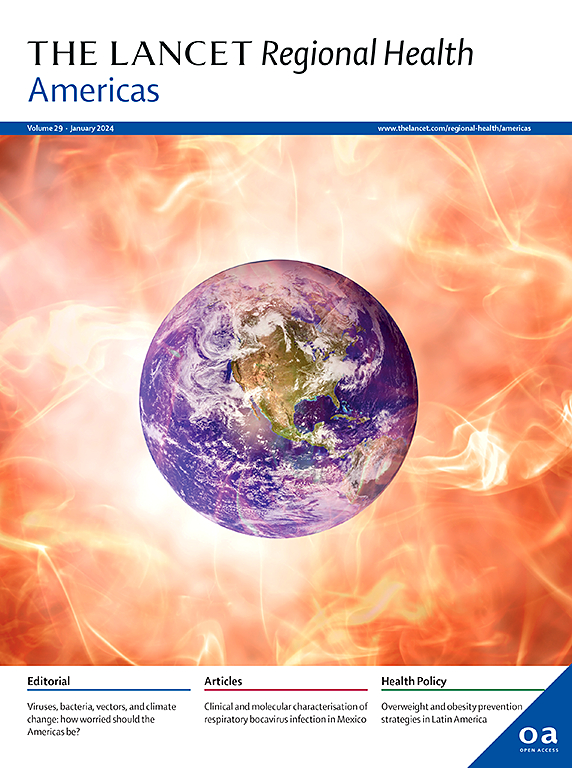基于点的SARS-CoV-2重症监护入住预测工具的推导和验证:基于人群的建模研究
IF 7
Q1 HEALTH CARE SCIENCES & SERVICES
引用次数: 0
摘要
在COVID-19大流行期间,即使一小部分sars - cov -2感染者对重症监护的需求也使重症监护资源成为一个关键的社会瓶颈。我们之前开发了一个简单的基于回归的积分评分来预测加拿大安大略省的重症监护占用率,使用病例数、病例平均年龄和检测量。在本研究中,我们旨在验证和更新该预测模型,以考虑不断变化的人群免疫力,包括广泛接种疫苗的影响。方法获取2020年3月至2022年9月全省SARS-CoV-2病例、检测和疫苗接种的完整数据,将疫情细分为6波。我们的初始模型是使用前两波的数据拟合的;更新的型号包括wave 3,主要是N501Y+变体。我们通过比较未用于拟合的波浪的投影来验证模型。预测效度采用Spearman’s rho进行评估。模拟了未接种疫苗的反事实情景,以估计疫苗导致的危重病住院率的降低。发现初始模型(波1-2)校准良好(rho = 0.85),但预测效度不高(rho = 0.46)。模型拟合到波1-3后,预测效度提高,不接种疫苗(rho = 0.60)和接种疫苗(rho = 0.68);接种疫苗后模型拟合显著改善(p = 0.013)。由于接种疫苗而避免入院的人数估计为144%(预计为22,017人,观察为9020人)。简单的基于回归的预测工具对于预测SARS-CoV-2重症监护占用率仍然有价值。然而,在大流行早期建立的模型应该重新校准,以考虑到不断演变的免疫,包括广泛的疫苗接种。资助加拿大卫生研究所(OV4-170360);R.霍华德·韦伯斯特基金会(通过多伦多大学流行病研究所)。本文章由计算机程序翻译,如有差异,请以英文原文为准。
Derivation and validation of a point-based forecasting tool for SARS-CoV-2 critical care occupancy: a population-based modeling study
Background
The requirement for critical care in even a modest fraction of SARS-CoV-2-infected individuals made critical care resources a key societal chokepoint during the COVID-19 pandemic. We previously developed a simple regression-based point score to forecast critical care occupancy in Ontario, Canada, using case numbers, mean age of cases, and testing volume. In this study, we aimed to validate and update this forecasting model to account for evolving population immunity, including the effects of widespread vaccination.
Methods
We obtained complete provincial SARS-CoV-2 case, testing, and vaccination data from March 2020 to September 2022, subdividing the pandemic into six waves. Our initial model was fitted using data from the first two waves; an updated model included wave 3, which was dominated by N501Y+ variants. We validated the models by comparing projections to waves not used for fitting. Predictive validity was assessed using Spearman's rho. Counterfactual scenarios without vaccination were modeled to estimate vaccine-attributable reductions in critical care admissions.
Findings
The initial model (waves 1–2) was well calibrated (rho = 0.85) but had modest predictive validity (rho = 0.46). Predictive validity improved with models fitted to waves 1–3, both without (rho = 0.60) and with vaccination (rho = 0.68); model fit improved significantly with vaccination (p = 0.013). Averted admissions attributable to vaccination were estimated at 144% (22,017 expected vs. 9020 observed).
Interpretation
Simple regression-based forecasting tools remain valuable for predicting SARS-CoV-2 critical care occupancy. However, models developed early in the pandemic should be recalibrated to account for evolving immunity, including widespread vaccination.
Funding
Canadian Institutes of Health Research (OV4-170360); R. Howard Webster Foundation (via the University of Toronto Institute for Pandemics).
求助全文
通过发布文献求助,成功后即可免费获取论文全文。
去求助
来源期刊

Lancet Regional Health-Americas
Multiple-
CiteScore
8.00
自引率
0.00%
发文量
0
期刊介绍:
The Lancet Regional Health – Americas, an open-access journal, contributes to The Lancet's global initiative by focusing on health-care quality and access in the Americas. It aims to advance clinical practice and health policy in the region, promoting better health outcomes. The journal publishes high-quality original research advocating change or shedding light on clinical practice and health policy. It welcomes submissions on various regional health topics, including infectious diseases, non-communicable diseases, child and adolescent health, maternal and reproductive health, emergency care, health policy, and health equity.
 求助内容:
求助内容: 应助结果提醒方式:
应助结果提醒方式:


